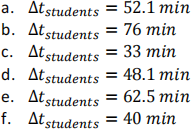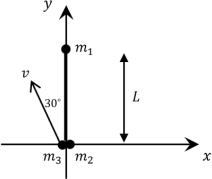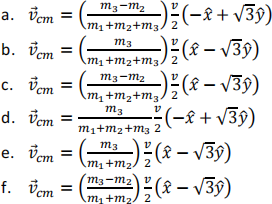Physics 1 – 114051 Final Exam B
Hello, dear friend, you can consult us at any time if you have any questions, add WeChat: daixieit
Physics 1 – 114051
Final Exam B – 17/02/2023 – 14:00-17:00
1. Question 1
A small ball of mass m is thrown horizontally from the top of a building of height ℎ with an initial horizontal velocity v0 . Two forces act on the ball during its motion: gravity and a horizontal force exerted by the wind given by f = −at, where a is a known positive constant.
It is given that the ball hits the ground exactly at the bottom of the building. What is the initial velocity v0 ?

2. Question 2
A particle of mass m moves in one-dimension with potential energy given by U(x) = bx2, where b is
known positive constant. At t = 0 the particle is at x = 0 and its velocity is −v0 ![]() . What is the position of the body at later time t?
. What is the position of the body at later time t?

3. Question 3
Two particles A and B can move along the x axis without friction. Particle A has mass m and is placed at the origin. Particle B has mass 2m and is at x = L0 > 0. Between the two particles acts a repulsive force that depends on the distance between the particles T of form F = ![]() , where D is some known positive constant.
, where D is some known positive constant.
At t = 0, particle A is given initial velocity +v0 ![]() and particle B is released from rest.
and particle B is released from rest.
It is given that at t = t0, particle A is at x = L0, what is the position of particle B at this moment?

4. Question 4
A student stands on an elevator at the ground level. At t = 0 the elevator begins to move upward with constant speed U = 5 m/s . Assume that the elevator reaches constant speed U at negligible time.
At moment t = 2 s, the student throws a ball parallel to the elevator’s floor (that is, horizontally) at speed of v = 10 m/s, relative to the student. What is the horizontal distance the ball will cover until it hits the ground? Use g = 10 m/s2 and neglect air friction.

5. Question 5
A car travels on a flat road. The car’s velocity vector as function of time is given by

Which statement is correct about the motion of the car at t = 1 s?
a. At this moment the car changes its direction of motion and increases its speed.
b. At this moment the car changes its direction of motion and decreases its speed.
c. At this moment the car moves on a straight line (there is change in the direction of motion) and increases its speed.
d. At this moment the car moves on a straight line (there is change in the direction of motion) and decreases its speed.
e. At this moment the velocity of the car does not change, no change in direction and no change in speed.
f. At this moment the car changes its direction of motion but there is no change in its speed.
6. Question 6
Spacecraft 1, containing students taking a physics exam, approaches the Earth with a speed of 0.6c (relative to the Earth), while spacecraft 2, containing teachers monitoring the exam, moves at 0.28c (relative to the Earth) directly toward the students.
If the teachers stop the exam after 50 min have passed on their clock, for what time interval does the exam last as measured by the students?

7. Question 7
A rod of length L and negligible mass is placed on a horizontal and frictionless table. Two point masses
of mass m each connected to each end of the rod at points ( − ![]() , 0) and (
, 0) and (![]() , 0). A point mass 2m travels with constant velocity v0
, 0). A point mass 2m travels with constant velocity v0 ![]() , hits the rod at point ( −
, hits the rod at point ( − ![]() , 0) and sticks to it.
, 0) and sticks to it.
What is the angular velocity 仙 of the system about the center of mass after the collision?

8. Question 8
A particle of mass m moves under the action of a conservative force whose potential energy is given by

Where U0, a and x0 are known positive constants.
Find the equilibrium points of this potential and specify their type.
a. Two stable equilibrium points at x = ±1/√a and an unstable equilibrium at x = 0.
b. One stable equilibrium at x = 0.
c. Two unstable equilibrium points at x = ±1/√a.
d. Two unstable equilibrium points at x = ±1/√a and a stable equilibrium at x = 0.
e. One unstable equilibrium at x = 0.
f. Two stable equilibrium points at x = ±1/√a.
9. Question 9
Two carts are standing at rest on a horizontal and frictionless surface. One cart is of mass m and the second cart is of mass 2m . A constant force acts on the first cart for a certain time period and accelerates it to speed v .
What is the final speed of the second cart if the same force acts on it for the same period of time as on the first cart?

10. Question 10
A small block of mass 2m initially rests on a track at the bottom of the circular, vertical loop-the-loop shown below, which has a radius R . The surface contact between the block and the loop is frictionless. A bullet of mass m strikes the block horizontally with initial speed v0 and remains stuck inside the block as the block and bullet circle the loop.
What is the minimal initial velocity of the bullet to keep the system block + bullet in contact with the
track at all times?

11. Question 11
Frame S′ travels with velocity ![]() = 0.99c
= 0.99c![]() relative to frame S .
relative to frame S .
Observer in frame S measures a distance L = 120 m (along the x axis) between two unstable particles in frame S′ . At a certain moment, an observer in frame S ′ measures that the two particles decay simultaneously.

According to the observer in frame S, what is the time interval between the decay of the two particles? And which particle decayed first? (Where F = u/c)

12. Question 12
A particle of rest mass m0 and relativistic speed v collides with a particle at rest of mass M and sticks to it. What is the final speed vf of the composite particle?

13. Question 13
Three point masses m1, m2 and m3 are connected to the ends of a massless rod of length L and negligible mass that is placed along the y axis on a horizontal and frictionless table. Mass m1 connected to the upper end of the rod while m2 and m3 connected to the lower end at the origin.

At t = 0 an explosion occurs between m2 and m3 after which m3 gets disconnected from the rod and moves with velocity v at angle of 30 ∘ relative to the positive y axis. m2 remains connected to the rod.
What is the velocity of the center of mass of the system of the rod and two masses connected to it (m1 and m2 ) after the explosion?

2023-07-03